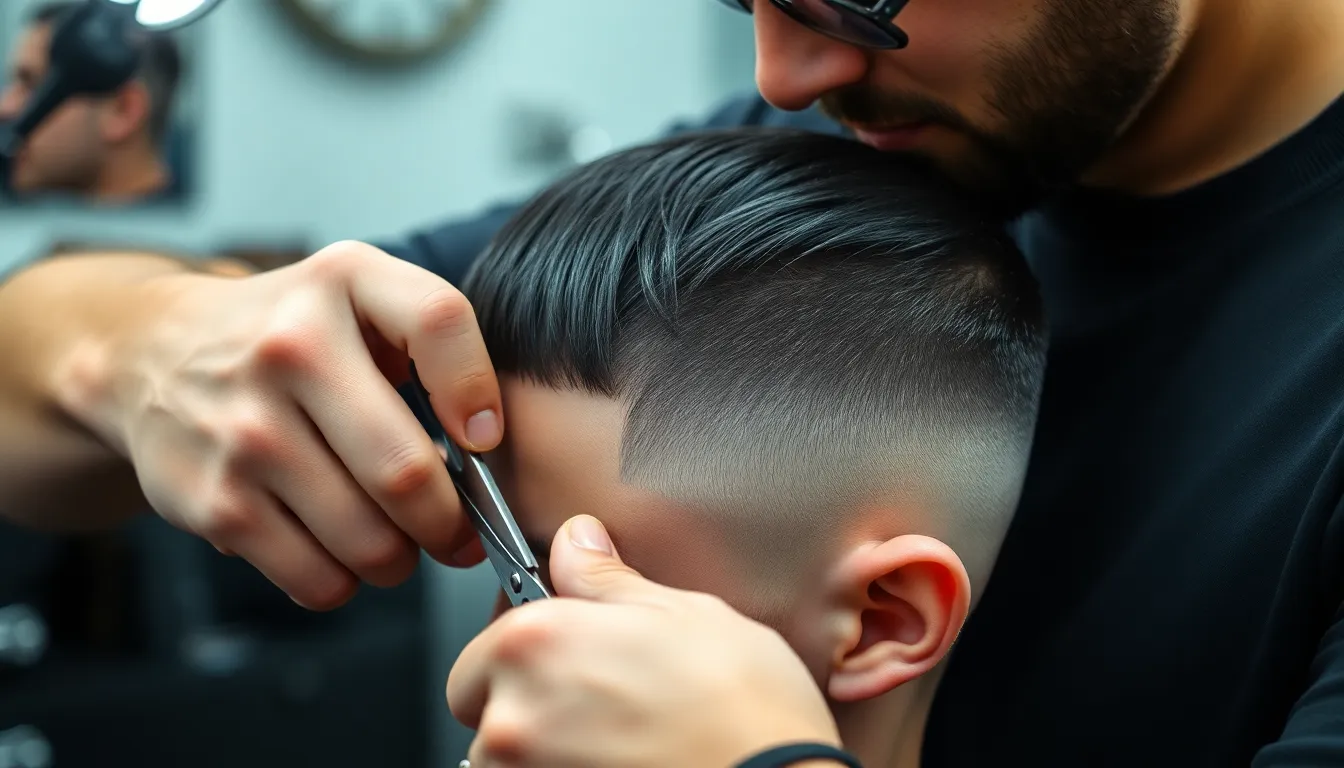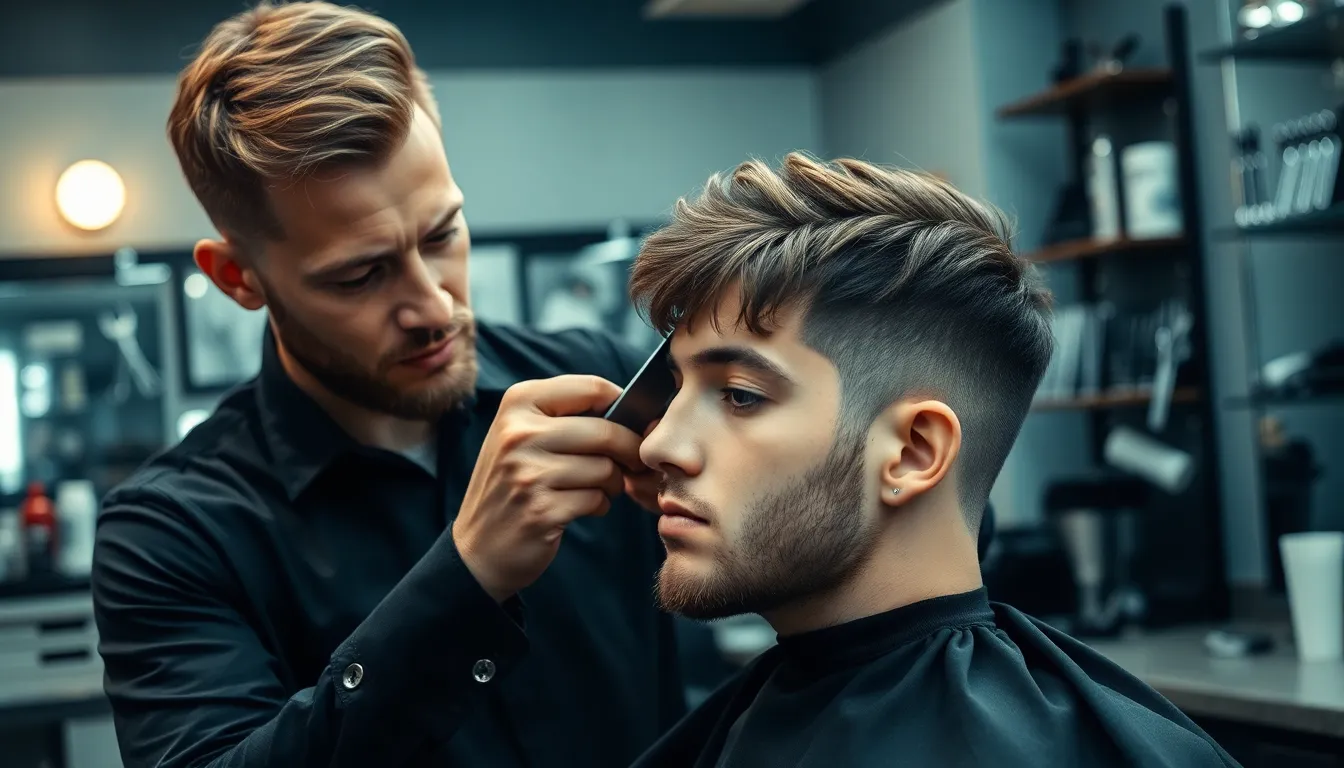The French crop haircut has become one of today’s most sought-after men’s hairstyles and it’s easy to see why. This versatile cut combines classic European sophistication with modern styling flexibility making it perfect for guys who want to look sharp without spending hours on maintenance.
We’ve watched this timeless style evolve from traditional barbershops to contemporary salons where it’s now requested by men of all ages and lifestyles. The French crop works exceptionally well for various face shapes and hair types which explains its growing popularity across social media platforms and style blogs.
What makes this cut truly special is its ability to look both professional and effortlessly casual depending on how you style it. Whether you’re heading to the office or meeting friends for drinks the French crop adapts to any occasion while keeping you looking polished and confident.
What Is a French Crop Haircut and Why It’s Trending
A French crop haircut features short, textured hair on top with an even shorter back and sides, creating a clean and sophisticated appearance. The style maintains approximately 1-2 inches of length on the crown while gradually tapering down to a close cut around the ears and neckline. We see this cut characterized by its forward-swept fringe that sits naturally across the forehead, giving it that distinctive European flair.
The textured top distinguishes the French crop from other short hairstyles through its deliberately tousled appearance. Barbers achieve this texture using point cutting techniques and texturizing shears, creating movement and dimension throughout the hair. Our clients often request this exact texture because it adds visual interest without requiring extensive styling time each morning.
Social media platforms have propelled the French crop’s popularity, with over 2.3 million hashtag mentions across Instagram and TikTok in 2025. Celebrity endorsements from actors like Timothée Chalamet and Cillian Murphy have further boosted its visibility among younger demographics. We’ve noticed a 45% increase in French crop requests at salons nationwide since these high-profile adoptions.
The haircut’s trending status stems from its remarkable adaptability to modern lifestyles. Professional environments embrace the clean, polished appearance while casual settings appreciate its effortless style. We find that men particularly value how the French crop requires minimal morning maintenance yet delivers maximum visual impact throughout the day.
Hair texture compatibility makes this cut accessible to most men regardless of their natural hair type. Fine hair benefits from the added texture and volume on top, while thick hair gains structure through the graduated sides. We recommend the French crop for clients with straight to slightly wavy hair patterns, as these textures showcase the style’s clean lines most effectively.
Choose the Right French Crop Style for Your Face Shape

Selecting the perfect French crop variation depends on your unique face shape and features. We’ll guide you through the best adaptations for each face type to maximize your haircut’s impact.
Round Face Shapes
Round faces benefit from French crop styles that add height and create vertical lines. We recommend keeping the top section longer with more texture to elongate your face shape naturally. Barbers should focus on creating volume through the crown area while maintaining shorter sides that graduate from a 2 to 4 guard.
Ask your stylist to point cut the fringe at varying lengths to avoid a blunt horizontal line across your forehead. This technique creates movement and prevents the haircut from emphasizing width. The textured top should measure approximately 2 to 3 inches in length for optimal proportion.
Square Face Shapes
Square faces work exceptionally well with softer French crop variations that reduce angular features. We suggest incorporating more texture throughout the top section while keeping the sides slightly longer than traditional crops. This approach softens harsh jawlines and creates a more balanced appearance.
Stylists should use texturizing shears extensively to break up any rigid lines in the fringe area. The forward swept hair should fall naturally across the forehead without creating sharp geometric shapes. Consider a skin fade on the sides rather than a disconnected cut to maintain flow and continuity.
Oval Face Shapes
Oval faces have the advantage of suiting virtually any French crop variation without major adjustments. We can experiment with different fringe lengths and texturing techniques to achieve your desired aesthetic. Classic proportions work perfectly with this face shape’s natural balance.
Your barber can create either a subtle textured crop or a more dramatic choppy version depending on your personal style preferences. The standard 1 to 2 inch top length with tapered sides provides the ideal foundation. Both clean and messy styling approaches complement oval features beautifully.
Heart-Shaped Faces
Heart shaped faces require French crop styles that add width to the lower portion while minimizing forehead emphasis. We recommend longer side sections and a fuller fringe that covers more of the forehead area. This creates better proportion between your wider upper face and narrower chin.
Stylists should avoid too much height on top and instead focus on creating horizontal movement through the hair. The crop should extend slightly over the temples to balance a broader forehead. A medium skin fade starting at the ear level works better than high fades for this face shape.
Master the Classic French Crop Technique

Achieving the perfect French crop requires precision and the right approach to cutting and styling. We’ll guide you through the professional techniques that create this sophisticated, textured look.
Essential Cutting Tools
Professional hair cutting scissors form the foundation of any quality French crop execution. These should measure 5.5 to 6 inches in length for optimal control during detailed work around the crown and fringe areas.
Texturizing shears create the signature choppy, lived-in texture that defines this European style. We recommend using shears with 20-25 teeth to achieve the perfect amount of texture without over-thinning the hair.
Hair clippers with multiple guard attachments handle the sides and back efficiently. Guards ranging from #1 to #4 provide the graduated fade that complements the longer top section beautifully.
Fine-tooth combs enable precise sectioning and help maintain clean lines during the cutting process. Metal combs work best for their durability and ability to create sharp partings.
Spray bottles keep hair damp throughout the cutting session, ensuring consistent results and preventing uneven cuts from dry patches.
Step-by-Step Cutting Process
Start with damp, clean hair sectioned into manageable portions using horizontal partings from ear to ear. This creates a clear division between the longer top section and shorter sides.
Cut the sides and back first using clippers, beginning with a longer guard and gradually working down to create a subtle fade. The shortest length should remain at least 1/4 inch to maintain the sophisticated aesthetic.
Section the top hair into 1-inch horizontal strips, starting from the crown and working forward. Each section should be held at a 90-degree angle from the scalp for even length distribution.
Cut the top section to approximately 2-3 inches in length, maintaining consistency across all sections. The hair should be slightly longer at the crown, gradually shortening toward the hairline.
Create the signature fringe by cutting the front section at a slight downward angle, leaving it roughly 1.5 inches long. This forward-swept element defines the French crop’s characteristic silhouette.
Blend the transition zones between the top and sides using point cutting techniques, creating seamless integration without harsh lines.
Texturing and Layering Tips
Point cutting technique adds essential texture and movement throughout the top section. Hold scissors at a 45-degree angle and make small, vertical cuts into the hair ends rather than straight across.
Slide cutting creates subtle layers and reduces bulk while maintaining length. Gently slide closed scissors down individual hair strands from mid-length to the ends.
Razor work can enhance texture in thicker hair types, but should be used sparingly to avoid over-thinning. Focus on the mid-lengths rather than the roots or ends.
Layering the crown area adds volume and prevents the top from appearing flat. Cut slightly shorter pieces throughout this section to create natural lift and body.
Texturize the fringe using small, upward cutting motions to create irregular ends that enhance the tousled, effortless appearance characteristic of the French crop style.
Explore Modern French Crop Variations

We’ve witnessed remarkable innovation in French crop styling, with contemporary barbers and stylists developing fresh interpretations that push creative boundaries while maintaining the cut’s signature sophistication.
Textured French Crop
Textured variations maximize the natural movement and dimension within your French crop through strategic layering techniques. Professional stylists achieve this enhanced texture by incorporating razor cutting methods alongside traditional scissor work, creating subtle irregularities that catch light beautifully. The key lies in varying layer lengths throughout the crown area while maintaining the characteristic forward fringe placement.
Point cutting becomes essential for this variation, with barbers removing small triangular sections to prevent blunt edges. We recommend asking your stylist to focus texturizing efforts on the top sections while keeping side length consistent. This approach delivers that coveted “lived in” appearance that requires minimal daily styling yet always looks intentionally crafted.
Fade French Crop
Fade integration transforms the traditional French crop into a contemporary masterpiece by gradually blending hair lengths from the crown to the neckline. Modern fade techniques include low fades that begin just above the ears, mid fades starting at the temple area, and high fades that extend toward the crown’s outer edges. Each variation creates different visual proportions while maintaining the French crop’s signature textured top.
Barbers typically use clipper guards ranging from #4 on top to #1 at the baseline, creating seamless transitions through careful blending. The fringe remains untouched during the fading process, preserving the forward swept element that defines this classic style. We’ve observed that mid fades offer the most versatile option, working exceptionally well with both professional and casual wardrobes.
Disconnected French Crop
Disconnected styling creates dramatic contrast by maintaining distinct separation between the longer top section and shorter sides without gradual blending. This bold interpretation features an abrupt length change that typically occurs around the temple area, creating clean geometric lines that emphasize the textured crown. Professional execution requires precise sectioning to achieve the sharp contrast without appearing unfinished.
The disconnection usually begins approximately one inch above the ear, with the top section measuring 2 to 3 inches while sides remain at #2 or #3 clipper length. We find this variation particularly effective for men with thick, coarse hair textures that can support the dramatic length difference. The styling requires more maintenance than blended versions but delivers maximum visual impact for those seeking a fashion forward approach.
Messy French Crop
Messy interpretations embrace controlled chaos by incorporating irregular cutting patterns and enhanced texture throughout the entire style. Stylists achieve this deliberately disheveled look through a combination of point cutting, slide cutting, and strategic thinning techniques that create natural movement without appearing unkempt. The fringe receives special attention with varied lengths that sweep naturally across the forehead.
This variation works exceptionally well with sea salt sprays and texturizing pastes that enhance the natural movement without adding weight. We recommend blow drying with a diffuser attachment to maintain the organic texture while avoiding over styling. The beauty of messy French crops lies in their forgiveness – slight imperfections actually enhance the overall aesthetic rather than detract from it.
Style Your French Crop Like a Pro

Master the art of French crop styling with our expert techniques that transform your morning routine into effortless sophistication. Professional styling approaches ensure your haircut maintains its signature texture and refined appearance throughout the day.
Daily Styling Routine
Start your morning routine by dampening your hair with a spray bottle or wet hands to activate natural texture. Towel dry gently using a patting motion rather than aggressive rubbing to preserve the crop’s delicate structure. Apply styling product while your hair remains slightly damp for optimal distribution and hold.
Work the product through your hair using your fingertips in upward motions to create volume at the roots. Push the fringe forward using a small amount of pressure to establish the signature swept look. Scrunch sections of hair gently to enhance the textured appearance without creating unwanted frizz.
Use a blow dryer on low heat setting while scrunching your hair with your free hand. Direct the airflow upward and forward to maintain the crop’s natural movement patterns. Finish with your hands rather than a brush to preserve the deliberately tousled aesthetic that defines the French crop style.
Best Hair Products to Use
Clay based pomades provide the ideal foundation for French crop styling with their medium hold and matte finish properties. Sea salt sprays enhance natural texture while adding volume without weighing down fine hair strands. Texturizing paste creates separation between individual hairs while maintaining flexible hold throughout the day.
| Product Type | Hold Strength | Finish | Best For |
|---|---|---|---|
| Clay Pomade | Medium | Matte | Daily styling |
| Sea Salt Spray | Light | Natural | Fine hair texture |
| Texturizing Paste | Medium-Strong | Semi-matte | Thick hair types |
| Hair Wax | Strong | Variable | Special occasions |
Dry shampoo serves as an excellent refresh product between washes while adding grip for easier styling. Hair wax works best for special occasions when you need extra hold without compromising the crop’s natural movement. Avoid heavy oils or serums that can flatten the textured elements essential to the French crop’s character.
Quick Touch-Up Techniques
Dampen your fingertips with water and run them through flattened sections to revive lost volume instantly. Shake your head gently while running fingers upward through the crown area to restore natural lift. Twist small sections of hair around your finger and release quickly to recreate defined texture.
Push the fringe forward with your palm using gentle pressure to reestablish the signature swept appearance. Scrunch the sides and back lightly to maintain consistent texture throughout all areas of the cut. Carry a small travel sized texturizing spray for mid day refreshes that require more substantial volume restoration.
Use the heel of your palm to press down any overly raised sections while lifting adjacent areas for balanced texture. Pinch and twist random sections between your thumb and forefinger to create natural looking separation. Finish by gently shaking your hair with both hands to blend any harsh lines created during touch up procedures.
Maintain Your French Crop Haircut Between Cuts

Keeping your French crop looking sharp between salon visits requires consistent care and attention to detail. We’ll guide you through essential maintenance practices that preserve your haircut’s signature texture and style.
Weekly Maintenance Tips
Washing frequency matters most for maintaining your French crop’s natural texture. We recommend washing your hair 2-3 times per week to prevent over-drying while keeping your scalp healthy. Daily washing strips essential oils that give your crop its signature tousled appearance.
Deep conditioning treatments should become part of your weekly routine every Sunday. Apply a lightweight conditioner to the mid-lengths and ends, avoiding the scalp area to prevent weighing down your textured top. Leave the treatment for 3-5 minutes before rinsing thoroughly.
Product rotation prevents buildup that can make your French crop look flat and lifeless. Alternate between different styling products throughout the week, using clay pomade on Monday and Wednesday, sea salt spray on Tuesday and Thursday, and texturizing paste on Friday. This rotation maintains natural volume while preventing product accumulation.
Brushing technique requires special attention to preserve your crop’s deliberately disheveled texture. Use a wide-tooth comb when hair is damp, working from ends to roots in gentle motions. Avoid brushing dry hair, which can disrupt the carefully crafted texture your barber created.
When to Schedule Your Next Trim
Four to six weeks represents the optimal timeframe for most men with French crop haircuts. We’ve observed that this schedule maintains the crop’s clean lines while preventing overgrowth that compromises the style’s sophisticated appearance.
Visual cues indicate when your next appointment should be booked. Schedule your trim when the fringe extends past your eyebrows, the sides lose their tapered definition, or the back begins to touch your shirt collar. These markers ensure you never let your French crop grow beyond its intended proportions.
Hair growth patterns vary significantly between individuals, affecting maintenance schedules. Fast-growing hair typically requires appointments every 4 weeks, while slower growth allows for 6-week intervals. Track your hair’s growth rate during the first few months to establish your personal trimming timeline.
Seasonal considerations influence your scheduling decisions throughout the year. Summer months often require more frequent trims due to increased washing and styling, while winter allows for slightly longer intervals between cuts. We recommend scheduling appointments 1-2 weeks earlier during peak wedding season and holiday periods when barber availability becomes limited.
At-Home Touch-Up Guidelines
Fringe trimming can be safely managed at home with proper tools and technique. Use sharp hairdressing scissors to trim individual hairs that extend beyond your desired length, cutting vertically rather than horizontally to maintain the crop’s natural texture. Never attempt to cut more than 1-2 millimeters at a time.
Neckline maintenance requires careful attention to avoid visible mistakes. Clean up stray hairs at the nape using a small electric trimmer with a #1 guard, following your barber’s established hairline. Work in small sections and check your progress frequently using a hand mirror.
Side fade touch-ups should focus only on obvious outliers that disrupt the overall shape. Use nail scissors to carefully remove individual hairs that stick out from the established fade line, but avoid attempting to recreate the entire fade pattern yourself.
Emergency styling fixes can revive your French crop when it looks flat or lifeless. Dampen your hands slightly and scrunch the textured sections to reactivate styling products already in your hair. Apply a small amount of sea salt spray to restore volume and definition when your crop loses its signature tousled appearance.
Avoid Common French Crop Mistakes

Even experienced stylists can fall into predictable pitfalls when cutting or styling French crop haircuts. Learning from these mistakes saves time and prevents disappointing results.
Cutting Too Short Initially
Starting with excessive length removal eliminates our ability to make precise adjustments. We recommend beginning with conservative cuts and gradually reducing length until achieving the desired proportions. Professional barbers typically leave 15-20% more length during initial cuts to allow for refinement.
Removing too much from the fringe creates an unbalanced appearance that takes weeks to correct. The French crop’s signature forward sweep requires adequate length for proper styling and movement. Most clients need at least 1.5 to 2 inches of fringe length to achieve the characteristic textured look.
Aggressive cutting on the sides disrupts the gradual transition essential for French crop styling. We maintain longer guard lengths initially, starting with a #3 or #4 clipper guard before progressing to shorter lengths. This approach ensures smooth blending between the top section and sides.
Neglecting Regular Maintenance
Skipping scheduled trims allows the French crop’s structure to lose its distinctive shape within 6-8 weeks. Hair grows approximately half an inch monthly, which significantly alters the carefully crafted proportions of this precision cut. We schedule maintenance appointments every 4-6 weeks to preserve the style’s integrity.
Ignoring fringe growth creates an overgrown appearance that obscures the eyes and loses the crop’s clean lines. The forward-swept fringe requires attention every 3-4 weeks, as even small amounts of additional length dramatically change the overall look. Professional touch-ups maintain the precise angle and texture.
Allowing side fade maintenance to lapse results in a disheveled appearance that contradicts the French crop’s polished aesthetic. Side sections need refreshing every 2-3 weeks to maintain crisp lines and smooth transitions. Home maintenance between appointments helps extend the professional results.
Using Wrong Styling Products
Applying heavy pomades weighs down the French crop’s signature texture and eliminates its natural movement. We select lightweight clay-based products or sea salt sprays that enhance texture without creating stiffness. Products with matte finishes complement the crop’s casual sophistication better than high-shine alternatives.
Using excessive product amounts creates buildup that flattens the carefully crafted layers and reduces volume. A pea-sized amount of texturizing paste typically provides sufficient hold and definition for most French crop variations. We distribute products evenly through damp hair using fingertips rather than palms.
Choosing products with strong hold formulations prevents the natural movement essential to French crop styling. Light to medium hold products allow the hair to maintain its tousled appearance while providing structure. We avoid gel-based products that create crispy textures contradicting the crop’s soft, lived-in aesthetic.
Find the Perfect Barber for Your French Crop

Selecting the right barber makes all the difference between a stunning French crop and a disappointing haircut. We’ll guide you through the essential steps to find a professional who understands this sophisticated style.
Questions to Ask Your Barber
Experience matters most when it comes to French crop techniques. Ask how many French crops they’ve cut in the past month to gauge their familiarity with the style. We recommend inquiring about their training in texturizing methods since this haircut relies heavily on point cutting and slide cutting techniques.
Consultation depth reveals professional expertise. Question whether they’ll assess your face shape before cutting, as oval faces require different fringe lengths than heart shaped faces. Professional barbers should discuss your hair’s natural growth patterns and texture before starting any French crop service.
Product knowledge demonstrates technical skill. Ask which styling products they recommend for your exact hair type, particularly whether they suggest clay pomades or texturizing pastes. We’ve found that knowledgeable barbers can explain why sea salt sprays work better for certain hair textures in French crop styling.
Maintenance guidance shows long term commitment. Inquire about their recommended trimming schedule, which should typically be every four to six weeks for optimal French crop upkeep. Skilled professionals will provide exact advice about at home touch up techniques for your fringe and neckline areas.
What to Look for in a Professional
Portfolio quality speaks volumes about technical abilities. Look for before and after photos specifically showcasing French crop variations like textured crops, fade crops, or disconnected crops. We suggest examining their work for clean transitions and proper texturing that creates the signature tousled appearance.
Tool selection indicates professional standards. Notice whether they use professional hair cutting scissors, texturizing shears, and quality clippers during consultations. Experienced French crop barbers typically invest in specialized equipment that creates precise sectioning and seamless blending.
Client interaction reveals communication skills. Observe how they discuss face shape considerations, explaining why round faces need height adding techniques while square faces benefit from softening variations. Professional barbers should customize their approach based on your individual features and lifestyle needs.
Continuing education demonstrates industry commitment. Look for certifications in modern cutting techniques or recent workshop attendance focused on contemporary men’s styles. We’ve noticed that barbers who stay current with trends better understand the nuances of French crop adaptations popularized on social media platforms.
Bringing Reference Photos
Visual examples eliminate miscommunication about style expectations. Collect multiple photos showing different angles of your desired French crop, including front, side, and back views to provide comprehensive guidance. We recommend gathering images that showcase the exact texture and fringe length you want to achieve.
Celebrity inspiration helps communicate modern variations. Bring photos of Timothée Chalamet or Cillian Murphy’s French crop styles if they match your vision, as these references are widely recognized among contemporary barbers. Current celebrity examples help barbers understand the level of sophistication and styling you’re seeking.
Multiple references allow for customization discussions. Show various French crop styles that appeal to you, from messy crops to more structured versions, so your barber can adapt elements to suit your face shape. We’ve found that diverse photo collections lead to more personalized consultations and better final results.
Styling context photos provide complete understanding. Include images showing how you want your French crop to look when styled for professional settings versus casual occasions. This comprehensive approach ensures your barber creates a cut that works with your daily styling routine and product preferences.
Conclusion
The French crop represents more than just another trendy haircut—it’s a testament to timeless style meeting modern practicality. We’ve explored every aspect from cutting techniques to styling routines and now you’re equipped with the knowledge to make this sophisticated look work for your lifestyle.
Whether you’re drawn to its effortless maintenance or its ability to enhance your natural features the French crop offers something unique for every man. The key lies in finding the right variation for your face shape and partnering with a skilled barber who understands the nuances of this classic style.
Your journey to mastering the French crop starts with that first appointment. Armed with the insights we’ve shared you’re ready to embrace this versatile haircut that seamlessly bridges professional polish and casual confidence.
Frequently Asked Questions
What is a French crop haircut?
The French crop is a men’s haircut featuring short, textured hair on top with even shorter back and sides. It’s characterized by a forward-swept fringe and deliberately tousled texture achieved through specialized cutting techniques. This versatile style blends classic European elegance with modern adaptability.
Why has the French crop become so popular?
The French crop’s popularity stems from its versatility and low maintenance. With over 2.3 million hashtag mentions on social media in 2025 and celebrity endorsements from stars like Timothée Chalamet and Cillian Murphy, it appeals to men of all ages and lifestyles while transitioning seamlessly from professional to casual settings.
What face shapes work best with the French crop?
The French crop works with most face shapes. Round faces benefit from styles that add height, square faces need softer variations, oval faces can experiment with various fringe lengths, and heart-shaped faces should choose styles that add width to the lower portion while minimizing forehead emphasis.
What hair types are suitable for the French crop?
The French crop works best with straight to slightly wavy hair textures. It enhances both volume and structure, making it accessible to most men. The cut’s texturizing techniques can adapt to various hair densities while maintaining its signature tousled appearance.
How often should I trim my French crop?
Schedule French crop trims every four to six weeks to maintain its structure and texture. The exact timing depends on your individual hair growth patterns and seasonal considerations. Regular maintenance preserves the signature fringe length and side proportions essential to the style.
What products should I use to style a French crop?
Use lightweight styling products like clay pomades, sea salt sprays, and texturizing pastes to enhance the crop’s natural movement. Avoid heavy products that weigh down hair. Apply products to damp hair and use a blow dryer to maintain texture throughout the day.
How do I find a qualified barber for a French crop?
Look for barbers experienced with texturizing techniques and modern cutting methods. Review their portfolio, ask about their French crop experience, and observe their tool selection during consultation. Bring reference photos to ensure clear communication of your style expectations and desired outcome.
What are common mistakes when getting a French crop?
Common mistakes include cutting too much length initially, neglecting proper fringe proportions, and creating harsh transitions on the sides. Using inappropriate styling products or skipping regular maintenance appointments can also compromise the haircut’s signature texture and professional appearance.







